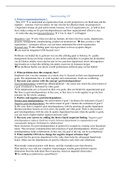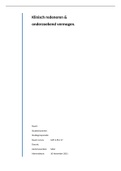Samenvatting OT
1. What is organization theory?
- Why OT? to understand an organization from several perspectives (six blind man and the
elephant – iedereen voelt iets anders, dit laat zien dat het allemaal draait om perspectief)
- Organisatie bestaat uit goal achievement, bonuses, level of organization etc., je hebt al deze
losse stukjes nodig om de goal interdependencies and their organizational effects te zien.
- Je werkt elke dag met personal theories if I do X, than Y will happen
Integrative view only when you add up: humans, division of power, teams, departments,
projects, management, manufacturing, product environment etc. then you have a full
organization + synergetic effects, you can better understand the whole organization
Focused view elke afdeling apart zijn eigen taken en focus op aparte dingen
you need an integrated AND focused view!
Probleem van bedrijf die te gefocust was om elke afdeling apart te belonen, bv. quality
management kreeg een bonus wanneer zij zero-defect aanhielden en zorgden dat de klachten
van de klanten minder waren dan het jaar ervoor, purchase department moest inkoopprijzen
laag houden en zo had elke afdeling iets anders waarvoor zij bonussen kregen
het probleem hierbij was dat de overall performance achteruit ging van het bedrijf
1. What problems does this company face?
Employers don’t see the company as a whole, they’re focused on their own department and
goals. The departmants have to work together and communicate. Goals are conflicting.
2. Recreate your answer with the concept ‘goal interdependence’
Goal interdependence (onderlinge afhankelijkheid) = the extent into which the achievement of
a goal is hindered or facilitated by other goals
the departments are so focused on their own goals, that can hinder the organizational goal.
But there is goal interdependence in this case, so they have to work together to get the best
outcome for the whole company.
3. Positive and negative goal interdependence
Positive goal interdependence: the achievement of goal 1 facilitates the realization of goal 2
Negative goal interdependence: the achievement of goal 1 hinders the realization of goal 2
In this case, there is negative goal interdependence with the purchase & quality department.
Because purchase focuses on a low price, the quality isn’t that good. There is also positive
goal interdependence with the sales & quality department because when the quality is good,
you can reach a higher market segment and more sales.
4. Recreate your answer by adding the theory-based empirical finding: Negative goal
interdependence induces (leidt tot) rivalry between departments in organizations and
consequently hampers (belemmert) collaboration!
Raise awareness for goal interdependence in general for example by creating cross functional
teams. This increases communication and awareness of goal interdependence. Positive goal
interdependence helps collaboration. In this way, the goal of the org. can be accomplished.
5. What could the CEO do to change the negative impact of bonus trap?
Set goals that the previous department in the value chain help the subsequent department
bonus. Make sure the departments are positive linked to each other and collaborate.
Most people contrast practice with theory, and like examples more than theories
Maar practice zijn vaak niet complete waarnemingen waarbij generalization requires
abstraction from the individual firm or practice, based on impartial observation.
So, nothing as practical as a good theory!
1
,Organization a group of people and other resources combined to achieve a common goal,
corporation of different people
OR: social entities that are goal-directed, are designed as deliberately structured and
coordinated activity systems and are linked to distinct external environments
Organizations: public/private, profit/non-profit, international, charities etc.
Theory consists of a set of interrelated concepts, definitions and propositions that explain
or predict events or situations by specifying relations among variables
A theory:
Focuses on small part of reality
Abstracts of many other relevant aspects
Helps us see detail this way
Helps us understand that limited part of reality better
Is NOT the whole story, and needs to be seen in a larger theoretical context
Functions of organization theories:
• OTs open up your mind, and make you sensitive to ‘alternative’ ways of looking certain
phenomena’, and to integrate ‘partial truths’,
• OTs organize your thinking into ‘systematic thinking’ and ‘thinking twice’ before acting!
• Systematic thinking prevents people from confusion of tongue, and facilitate a systematic
debate and more informed intervention
• HOWEVER: ANY organization theory will necessarily have to
ignore some aspects of organizations and be overly simplistic about some others!
5 theories offer answers to 5 big organiz. questions, allow you to generate a bigger picture
Q1: How can organizations organize their interaction with the environment?
Inter-Organization Theories (TCT and RDT)
Once organizations are formed/born: how do organizations maneuver in their environment?
Q2: How do organization set goals?
Goal Setting Theory
Q3: What makes organizations different?
Dynamic Capabilities Theory
Q4: What causes organizations to become accepted entities?
Legitimacy Theory
Q5: When do (departments/teams in) organizations compete, when do organizations
collaborate?
Social Interdependence Theory + Inter-Organizational Theories
So organizations are our elephants
Organizations have to be different enough to remain competitive, but they also have to
be similar to remain legitimate (Q4 and Q5)
They have to compete on different markets on supply side, and on the demand side
Simultaneously they have to collaborate when they lack control over resources (Q1,
Q4, Q5 and Q6)
Organizational goals should be smart, avoid negative interdependence, and facilitate
positive interdpendence (Q2)
Whetten – 1989
A theory:
2
, Consists of a set of concepts (what) and the relationships that tie them together (how)
into an explanation of the phenomenon of interest (why)
Builds on a set of assumptions that form the foundation for a series of logically
interrelated claims
Elements of a theory: what, how, why + who, where, when:
1. What = which factors (variables, constructs, concepts) logically should be considered
as a part of the explantion of the social or individual pehnomena of interest
- Comprehensiveness = are all relevant factors included?
- Parsimony = should some factors be deleted because they add little additional value
2. How = how are the factors related? Arrows to connect the boxes, causality
What + How = the domain/subject of the theory
3. Why = what are the underlying psychological, economic, or social dynamics that
justify the selection of factors and the proposed causal relationships theoretical glue
4. Who, Where, When = these conditions place limitations on the propositions
generated from a theoretical model. These temporal and contextual factors set the
boundaries of generalizability, and as such constitute the range of the theory. Je komt
achter deze 3 door het proces van de anderen eerst te doorlopen en te testen.
EX1: What and how: decision quality
Decisions leading to desired processes and outcomes
Size CEO’s network = number of information ties of the CEO with…
What/how: size CEO’s network (positive +) decision quality
How: H1: the larger the size of a CEO’s network the higher his/her decision quality
Why: individual CEO’s with a relatively large network have better access to information
about business trends and strategies of competitors and therefore can make better informed
decisions
De lijn in de grafiek is dus
EX2: What and how: decision quality
What/how: size CEO’s network (negative -) decision quality
How: H2: the larger the size of a CEO’s network the lower his/her decision quality
3
, Why: individual CEO’s have limited cognitive capacity, and the more ties a CEO has, the
more diverse info she/he receives, the more ambiguous the information can become, and the
more she/he needs to process. This creates cognitive overload and deteriotes decision quality
De lijn in de grafiek is dus
What and how: CEO network size decision quality
Fist positive and then negative dit zijn H1 en H2 samen
Integrated in one model
EX3: What: team members’ creativity
Nature of relation: Interaction frequency and creativity performance:
4






